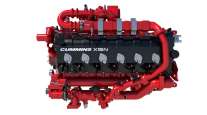Fleets Must Reshape Shops to Handle Natural Gas, Experts Say
This story appears in the Dec. 10 print edition of Transport Topics.
ARLINGTON, Va. — Fleet managers intent on choosing natural gas as a truck fuel will have to go through a complicated and expensive process to convert, including the development of training and maintenance procedures, said participants in the American Trucking Associations’ Summit on Natural Gas in Trucking.
Trucking executives who make the leap will have to pick engine and fuel types, modify their maintenance shops and possibly install new types of fueling equipment, speakers said here Nov. 29-30.
Despite the level of work required, some carriers have found it worthwhile.
“You can go crazy on diesel-gallon equivalents and gasoline-gallon equivalents, so I just look at fuel costs per mile traveled, and it’s impressive,” said Michael Lickert, fleet manager of Pittsburgh-based supermarket chain Giant Eagle Inc. His company uses heavy-duty tractors powered by compressed natural gas.
“We’re trying to develop as many commercial configurations as possible,” said Ryder System Inc. Vice President Scott Perry, who works in the company’s truck-leasing division.
Perry estimated the cost of outfitting a maintenance shop to work on natural-gas vehicles at $300,000 to $500,000 per shop.
Original equipment manufacturer Navistar Inc., Lisle, Ill., developed a manual for its dealerships, telling them how to adapt their maintenance shops for natural gas. The starting point is that natural gas is lighter than air.
“If it escapes, it goes up and will collect in the top 18 inches below the ceiling,” said Navistar engineer Nadine Haupt. “Take away all of the ignition points up there and put in methane detectors.”
Lickert said one of the reasons he prefers CNG is that it maintains the familiar stench caused by the insertion of mercaptan. In contrast, the intense cold of liquefied natural gas neutralizes the noxious smell.
Haupt said shop managers should remember that local building and fire codes are local ordinances and not federal laws, so they will have to deal with local fire marshals, too.
Carriers wishing to build CNG or LNG fueling stations at their terminals will have to face more maintenance challenges, said Exxon Mobil Corp. engineer Lilo Hurtado.
“Failure to maintain filters and blow-down traps” in CNG dispensers can “potentially impact engine operation,” Hurtado said.
Perry agreed, saying that using poorly maintained fueling equipment will cause problems that could easily be avoided. As for LNG fueling, Ryder has produced a video on how to fuel with LNG that shows it to be a complex process.
The pump operator should wear a protective apron and gloves and an anti-splatter face shield be-cause LNG is stored at minus 260 degrees Fahrenheit.
Hurtado also advised that pure CNG or LNG engines operate at higher temperatures than do conventional diesel engines. Therefore, they need special oils.
While there are several truck engines that use nothing but CNG or LNG with spark plug combustion, there is also a dual-fuel option to consider. Most of the fuel burned in the engine’s cylinders is natural gas, but there is also a bit of diesel — enough for the power plants to operate with traditional compression combustion.
A dual-fuel engine can also run on pure diesel in case a driver cannot find a natural-gas fueling station to refill his or her CNG or LNG tank. Dual-fuel systems are often added onto conventional diesel engines in a retrofit conversion process, said Scott Myers, CEO of EcoDual LLC.
Myers said that, even though the conversion systems have been used for diesel generators since 1935, they have had mixed success until recently for use in Class 8 trucks.
However, now dozens of engine families dating back to 2004 models already have been certified by the U.S. Environmental Protection Agency for dual fuel, and more are expected in the near term. The systems can be installed at a trucker’s own facilities or at an outside shop.
Myers said that the roughly $30,000 cost to purchase a dual-conversion system on a truck that logs 150,000 miles annually and burns natural gas up to 85% of the time can be paid back within a year.
The retrofits do not void a truck engine’s warranty, Myers said.
Myers estimated that only 3% to 5% of the roughly 200,000 Class 8 trucks manufactured annually are powered by natural gas, and he does not expect that balance to change soon.
However, he does predict that in the next three years, the number of Classes 6-8 dual-fuel trucks will exceed the number of 100% natural gas trucks,




